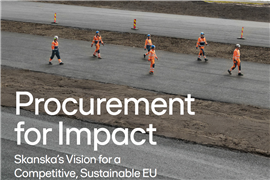Read this article in Français Deutsch Italiano Português Español
Icon’s 3D-printed village in Texas, US, nearing completion
30 May 2024
US-based 3D concrete-printing company, Icon, announced it’s nearing 100% completion of its Wolf Ranch subdivision, which includes 100 concrete-printed homes near Austin, Texas, US.
Using their gantry-style Vulcan 3D-printing robot, ICON says it’s cleared the 90-unit printing mark in Georgetown, Texas, amid a collaboration with American homebuilder Lennar. The homes were codesigned by Icon and Bjarke Ingels Group, a multinational design firm.
“We’ve completed [printing for] 95 homes,” confirmed Spencer Padgett, VP of construction for Icon, who expects Wolf Ranch to be finished next year.
“We have some of the lots taken up by our logistics and parking areas, so there’s three lots that are available and another two lots, which we will do next year.”
Padgett said the goal of Icon’s concrete-printed homes are to offer competitive prices for single-family homes; savings in time and materials from the process keep the homes’ prices at or below the regional average.
The homes in Wolf Ranch, which range in size from around 1,850 sq ft (172m2), start at around US$430,000. Vulcan can print structures up to 3,000 sq ft (279m2) within its nearly 16-ft (4.9m) by 47-ft (14m) frame.
Assuming the costs can stay there, it should be a productive market in Texas – particularly Georgetown outside of Austin – which is one of the fastest growing regions in the country.
“There is a large demand for single-story homes” he says, noting Icon’s Vulcan printer has become the group’s go-to machine for subdivision builds.
The structures are also constructed to be more climate resistant – using less organic materials than a traditional build – and energy efficient.
“We got a utility bill from one of the customers there from last week,” said Padgett of a new homeowner in Wolf Ranch. “For a 1,850 sq ft house, [the energy bill was] $35 for the entire month. It doesn’t rot, there’s no bugs that are going to eat it, it’s not effected by humidity,” continued Padgett, noting advantages. “The walls are just stronger.”
Padgett says the structures meet some of the nation’s highest standards for wind resistance, with the ability to endure gusts up to 250 mi/hr (402km/hr).
Wolf Ranch doesn’t ‘reinvent the floorplan’
Padgett noted, in the spirit of sustainability, the subdivision project didn’t go out of its way to redesign the future of home layouts.
While a gantry printer like Vulcan is known for offering versatility and dynamic design in a controlled on-site build, the project relied on consistency in architecture, using popular and existing floorplans from Lennar, which it modified to fit the printer’s needs.
“We came up with some really great designs that were kind of the 3D-translation of some of Lennar’s most popular floor plans,” he said.
Padgett noted an irony in showing the homes; even though it’s made with less organics (particularly wood), clients comment on the homes’ natural look. “There’s not a lot of sharp corners and edges, and it feels almost more organic in terms of a structure,” he said.
The cementitious paste, Padgett said, can remain ridged or rippled as it comes applied, or Icon can flatten the walls for a more conventional look, depending on customer’s needs.
Phoenix, the two-story printer
ICON recently launched – in March, at Austin’s annual South by Southwest festival – a 40-foot, second-story crane-style 3D-printer named Phoenix, which Padgett believes will help expand to meet more customer needs.
It’s a multi-faceted service that, Padgett says, should help round out what is a budding industry in the US: robotic concrete homebuilding.
“We’re finding what the market is looking for in terms of other automations,” he says, “and we will continue to investigate other automations that will add onto our main print system.”
Padgett said Phoenix will add flexibility to the fleet and was designed to be set up quickly and “very deployable or manoeuvrable on the job site.” It can print walls up to 27-ft tall.
Although it has extra reach, Phoenix will also be able to do foundation and ground-level work, as well.
“It allows us to go down and print a foundation, allows us to print the couple floors above, and even print roof structures for some of the homes and the areas where a concrete roof would benefit from an environmental protection perspective,” he added.
STAY CONNECTED



Receive the information you need when you need it through our world-leading magazines, newsletters and daily briefings.
CONNECT WITH THE TEAM











